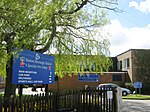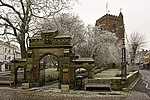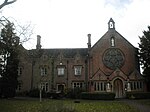Newport Rural District
Districts of England created by the Local Government Act 1894History of ShropshireLocal government in ShropshireNewport, ShropshireRural districts of England ... and 1 more
Use British English from August 2012
Newport was a rural district in Shropshire, England from 1894 to 1934. It was formed under the Local Government Act 1894 from that part of the Newport rural sanitary district which was in Shropshire (the rest, in Staffordshire, forming the Gnosall Rural District.) It was abolished in 1934 under a County Review Order, and was merged into the Wellington Rural District.
Excerpt from the Wikipedia article Newport Rural District (License: CC BY-SA 3.0, Authors).Newport Rural District
High Street,
Geographical coordinates (GPS) Address Nearby Places Show on map
Geographical coordinates (GPS)
| Latitude | Longitude |
|---|---|
| N 52.769 ° | E -2.379 ° |
Address
High Street
High Street
TF10 7AG , Newport
England, United Kingdom
Open on Google Maps










